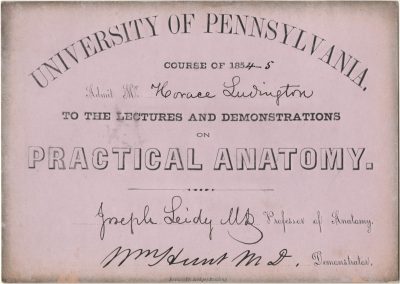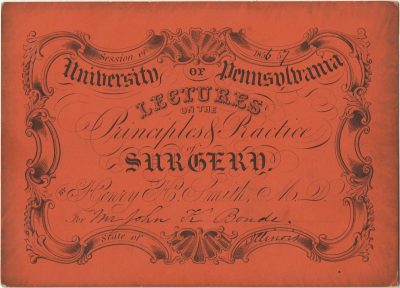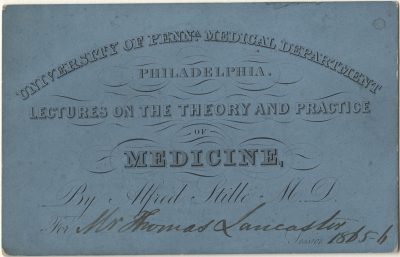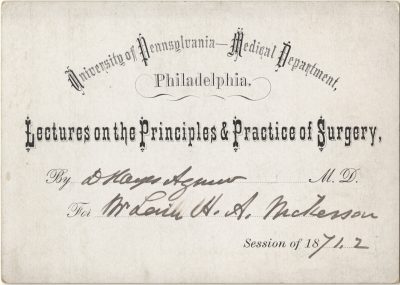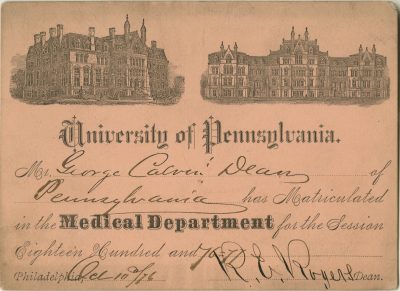87. Graduate's ticket, Edgar Janvier, 1848-49
| University of Pennsylvania 1848-49 Horner, W.E. (William Edmonds), MD (dean) Janvier, Edgar, MD Graduate’s ticket |
|
| Dean Horner (77) signed this Graduate’s Ticket that gave Janvier (Penn; M1847) a year’s worth of “postgraduate” education attending lectures in the Medical Department. This was his second year taking courses after obtaining his medical degree. A native of Pittsgrove, NJ, Janvier practiced in Philadelphia’s Port Richmond section at the time of this ticket and for years to follow. He was involved with the Philadelphia Board of Health as a “vaccine physician” and reporting on disease within the Richmond District.
Coffin, Selden J., PhD. Record of the Men of Lafayette: Brief Biographical Sketches of the Alumni of Lafayette College from Its Organization to the Present Time. Easton, PA: Skinner & Finch, Printers, 1879. 19-20.
Journal of the Select Council of the City of Philadelphia: Beginning May 10 and Ending November 4, 1858. Phila: Crissy & Markley, Printers, 1858. 248. |
|
88. Ticket to dispensary, Richard P. Daniel, 1851
| University of Pennsylvania 1851 Horner, W.E. (William Edmonds), MD (dean) Daniel, Richard P. Ticket to Dispensary |
|
| As the apprenticeship system was breaking down in the late 1830s and 1840s, Penn opened a dispensary in 1841 to afford students another means of practical instruction. This ticket for the summer of 1851 gave Daniel (Penn; M1851), a very recent medical school graduate, access to clinics and lectures at the Dispensary. The “vacation” ticket ideally suited students who lived far from Philadelphia and could not or chose not to return home for the summer between their two years of courses. Because Philadelphia was the most southern, northern city with a wealth of opportunities for medical education, it attracted large numbers of Southerners until the Civil War. During the war, 553 Confederate Army surgeons (25%) were Penn medical alumni, including the Confederacy’s first Surgeon General. Daniel, who hailed from Florida, served as surgeon in the 8th Infantry Regiment, Confederate States Army. He treated the wounded in battles at the 2nd Bull Run, Antietam, Gettysburg, The Wilderness, Appomattox and others.
“Civil War Connections: CSA.” ChazzCreations Limited. http://chazzcreations.com/military_service_family_history/csa_connections
Corner, George W. Two Centuries of Medicine: A History of the School of Medicine, University of Pennsylvania. Phila: J.B. Lippincott Company, 1965. 90-91, 115. |
|
89. Materia medica and pharmacy, Joseph Carson, 1851-52
| University of Pennsylvania 1851-52 Carson, Joseph, MD Buchanan, Sihon T. Materia medica and pharmacy |
|
| After graduating with a medical degree, Carson (Penn; M1830) served as surgeon on a voyage to India. The trip fostered opportunities for his interest in botany. Upon returning to Philadelphia he established a private practice for his other medical interest, obstetrics, which he eventually relinquished to pursue materia medica. Carson first taught this course at the Philadelphia College of Pharmacy (46). In 1844 he began 32 years of teaching materia medica at Penn, first as a lecturer and in 1850 as professor. Carson edited the Journal of Pharmacy from 1836 to 1850 and authored the centennial history of Penn’s Medical Department (1865). Little is known of Buchanan, who did not graduate from Penn’s Medical Department, other than that he was born in North Carolina and died in Mississippi.
Ancestry.com. http://www.ancestry.com/genealogy/records/sihon-t-buchanan_37497864
University of Pennsylvania Archives & Records Center. Penn Biographies, Joseph Carson (1808-1876). |
|
90. Anatomy, Joseph Leidy and William Hunt, 1854-55
| University of Pennsylvania 1854-55 Leidy, Joseph, MD and Hunt, William, MD (demonstrator) Ludington, Horace Anatomy |
|
|
Leidy (Penn; M1844) came to the chair of anatomy in 1853 as a naturalist and not a surgeon like his predecessors. By this time, he already had pioneered vertebrate anthropology in America and made important discoveries in botany, comparative anatomy, mineralogy and paleontology. He advanced public health with the identification of Trichina spiralis in pigs and other research on bacterial parasites. Leidy described his ideas about spontaneous generation, the origins of life and evolution years before Pasteur and Darwin. He chaired anatomy in Penn’s Medical Department for nearly four decades while founding and heading the University’s Department of Biology. His demonstrator, Hunt, was an 1849 Penn medical alumnus. During the Civil War, Ludington (Penn; M1855), one of roughly 663 Union Army surgeons trained at Penn, served as a major and surgeon with the 100th Pennsylvania Volunteer Infantry, known as the “Roundheads.” After the war he practiced in Pittsburgh and then Cincinnati. In 1878 he moved to Omaha where he worked for the Quarter-master’s Department of the Army.
Cooper, David Y., III and Marshall A. Ledger. Innovation and Tradition at the University of Pennsylvania School of Medicine: An Anecdotal Journey. Phila: University of Pennsylvania Press, 1990. 52-54.
Dr. Horace Ludington, Surgeon, Roundheads Zoominfo. http://www.zoominfo.com/#!search/profile/person?personId=1597791271&targetid=profile University of Pennsylvania Archives & Records Center. Penn Biographies, Joseph Leidy (1823-1891). |
|
91. Surgery, Henry H. Smith, 1856-57
| University of Pennsylvania 1856-57 Smith, Henry H., MD Bonde, John K. Surgery |
|
| Smith (Penn; M1837) began teaching at Penn as assistant in demonstrative surgery in 1849 and professor of surgery in 1855. During the Civil War the governor of Pennsylvania chose him to reorganize the state’s hospital system and appointed him Surgeon General of Pennsylvania. Smith devised plans to remove the wounded from the battlefield to large hospitals, to embalm the dead on the battleground, and to create floating hospitals. He authored A System of Operative Surgery (1852), the first American surgical textbook illustrated with photographs (daguerreotypes), and The Principles and Practice of Surgery Embracing Minor and Operative Surgery (1863), the only systematic textbook of surgery written during the Civil War. “State of Illinois,” home to Bonde (Penn; M1857), appears in this ticket’s ornate border. During the Civil War he served as Assistant Surgeon, 118th Regiment, Illinois Infantry, Army of the Tennessee. Bonde later worked as a medical referee in the Pension Office in Washington, DC.
The Daily Palladium. Vol. XXX, No. 116. Oswego, May 30, 1893. 1.
First Reunion of the Survivors of the Army of the Tennessee and Its Four Corps. Washington, DC: September 22, 1892. 196. Kelly, Howard A. and Walter L. Burrage. American Medical Biographies. Baltimore: The Norman Remington Company, 1920. 1068. Rutkow, Ira M., MD, MPH, DrPH. “Henry H. Smith’s A System of Operative Surgery.” Arch Surg. 1999;134(1):24. |
|
92. Medicine, Alfred Stillé, 1865-66
| University of Pennsylvania 1865-66 Stillé, Alfred, MD Lancaster, Thomas Medicine |
|
|
Stillé (Penn; M1836) worked as house physician at Philadelphia Hospital (3) under Drs. W.W. Gerhard (52) and Caspar Wistar Pennock, proponents of the French school of medical science based on connections between symptoms and postmortem examinations, observation and medical statistics. With his mentors, Stillé differentiated typhus from typhoid fever during Philadelphia’s 1837 typhus epidemic. A medical reformer, he was a driving force in founding the American Medical Association (1847), serving as its first secretary. He lobbied for higher entrance standards, longer sessions and fixed salaries for professors rather than lecture fees. In 1864 Stillé succeeded Pepper as Penn’s chair of medicine. Lancaster, an 1855 graduate of the Philadelphia College of Pharmacy (46), received his Penn medical diploma in 1866 with the thesis, “Moral and Physical Culture of Women.” He practiced in Philadelphia with special interest in throat, lung, stomach and urinary conditions. Through his travels, Lancaster explored climatology as it pertains to health.
Chamberlain, General Joshua L., LLD. University of Pennsylvania: Its History, Influence, Equipment and Characteristics; with Biographical Sketches and Portraits of Founders, Benefactors, Officers and Alumni. Vol. 2. Boston: R. Herndon Company, 1902. 213-14.
Kelly, Howard A. and Walter L. Burrage. American Medical Biographies. Baltimore: The Norman Remington Company, 1920. 1106-07. University of Pennsylvania Archives & Records Center. Penn Biographies, Alfred Stillé (1823-1891). |
|
93. Surgery, David Hayes Agnew, 1871-82
| University of Pennsylvania 1871-72 Agnew, David Hayes, MD Nickerson, Levin H.A. Surgery |
|
| Through prolific dissection and the study of anatomy, Agnew (Penn; M1838) prepared himself for a surgical career. In 1852 he purchased the Philadelphia School of Anatomy (48) to teach private pupils and expanded instruction to include operative surgery. While surgeon to Philadelphia Hospital (3) he established a pathological museum. Agnew started lecturing at Penn in 1858 and in the year of this lecture ticket, became professor of surgery. One of the nation’s leading surgeons, he treated President James Garfield, victim of an assassin’s bullet. Medical students honored their beloved professor’s retirement with the famous “Agnew Clinic” painted by Thomas Eakins. Nickerson (Penn; M1874), originally from Delaware, practiced in Quincy, Illinois.
Illinois Medical Directory 1910. Chicago: American Medical Association, 1910. 249.
Kelly, Howard A. and Walter L. Burrage. American Medical Biographies. Baltimore: The Norman Remington Company, 1920. 8-9. University of Pennsylvania Archives & Records Center. Penn Biographies, D. Hayes (David Hayes) Agnew (1818-1892). |
|
94. Matriculation ticket, George Calvin Dean, 1876-77
| University of Pennsylvania 1876-77 Rogers, R. (Robert) E., MD (dean) Dean, George Calvin Matriculation ticket |
|
| After more than 100 years in the city’s historic core, the University relocated west of the Schuylkill River. Illustrated here, Medical Hall (left), fitted out with lecture halls and laboratory space, opened in 1872. The University Hospital (right), the first university-affiliated teaching hospital built to advance the education of medical students, received patients in 1874. The laboratories and bedside instruction provided by these new facilities helped move Penn’s medical school in the direction medical reformers called for. Rogers (Penn; M 1836) was elected Penn’s professor of chemistry, succeeding his deceased brother (86), in 1852 and dean of medical faculty in 1856. When Penn pursued reforms that would change professors’ remuneration from fees to salaries, Rogers resigned and in 1872 joined Jefferson Medical College, where the fee system still prevailed. The back of the matriculation ticket, signed by the faculty, admitted Dean (Penn; M1877) to the University Hospital Clinics. Little is know about this medical student other than his thesis on “Intermittent Fever.”
Ruschenberger, W.S.W. “A Sketch of the Life of Robert E. Rogers, M.D., LL.D., with Biographical Notices of His Father and Brothers.” Proceedings of the American Philosophical Society. Vol. 23. No. 121. Jan., 1886. 104-146.
|
|
95. Materia medica and pharmacy, Horatio C. Wood, 1876-77
| University of Pennsylvania 1876-77 Wood, Horatio C., MD Stone, James Sumner Materia medica and pharmacy |
|
| Wood (Penn; M1862) supplemented his early practice in Philadelphia as a private teacher or quizmaster in Penn’s medical school. He was elected to chair botany in the University’s Auxiliary Faculty of Medicine. Appointments in nervous diseases, materia medica, pharmacy and therapeutics followed. His Treatise on Therapeutics (1874) became the principal American textbook on materia medica and therapeutics and influenced the idea of pharmacology as its own subject within the medical curriculum. Wood represented the United States in the 1902 Brussels Conference, which endeavored to establish international standards for pharmaceuticals. Stone (Penn; M1879) of West Virginia was a traveling deacon in the Methodist Episcopal Church. In the 1880s he and his wife served as missionaries in India, where they made inroads in cleaning up Bombay’s undesirable districts and inaugurated a monthly custom of hosting interfaith, multicultural gatherings in their home. Stone later served pastorates in New York City mission churches.
Katherine Louise Elson. http://www.jonesgenealogy.net/getperson.php?personID=I1983&tree=Jones
Minutes of the Annual Conferences of the Methodist Episcopal Church. NY: Phillips & Hunt, 1880. 242. Rev. Dr. James Sumner Stone. http://www.jonesgenealogy.net/getperson.php?personID=I108&tree=Jones Roth, George B. “Horatio C. Wood, Jr. 1841-1920.” Washington, DC: National Academy of Sciences, 1959. |
|
96. Institutes of medicine, James Tyson, 1877-78
| University of Pennsylvania 1877-78 Tyson, James, MD Walk, James Wilson Institutes of medicine |
|
| This lecture ticket reflects the last year Penn faculty issued individual lecture tickets as curriculum and administrative reforms in the Medical Department replaced the antiquated fee system with salaried faculty and a centralized “tuition” payment. Tyson (Penn; M1863), Penn’s first professor of pathology, was largely responsible for pathology developing into an independent academic discipline in the medical school. An advocate for reforms in medical education, his efforts resulted in higher admission standards and a lengthened curriculum. Tyson, along with William Osler, MD and other prominent physicians, organized the Association of American Physicians in 1885 to encourage experimentation in basic and clinical science, and the application of discoveries to clinical medicine. Walk (Penn; M1878) took a sabbatical from private practice to advance the city’s organized charities, becoming the first Director of City Charities and Correction. He also served two terms in the Pennsylvania House of Representatives and as Philadelphia’s director of the Bureau of Health.
Starr, Carol and William A. Gardner. “Philadelphia: Cradle of Pathology.” Virchows Arch. 2011 January; 458(1):31-38.
University of Pennsylvania Archives & Records Center. Alumni Records. University of Pennsylvania Archives & Records Center. Archival Collections, James Tyson, 1841-1919, Family Papers, 1854-1982. Walk, James Wilson Papers, 1866-1918. Skillman Library, Lafayette College. http://archives.lafayette.edu/sites/default/files/walk.pdf |
|




